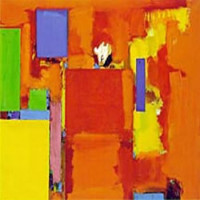4 Poets in The Kenyon Review

The Kenyon Review, founded in 1939 by John Crowe Ransom, was the most influential American literary magazine in the 1940s and 50s, and continues to publish the big names in American poetry.Game Length (Part Three) by Devon Branca is a long sequence from which I quote a few sections only, vignettes that are fairly self-explanatory and complete in themselves. The phrase ‘game length’ repeats as a linking device. Devon Branca teaches composition and literature at Morrisville State College, and the whole sequence can be read here:
http://www.kenyonreview.org/kr-online-issue/2013-summer/selections/devon-branca-763879/
Section 29 has Mark and someone sleeping together.
always heavier
than the heavier Mark seeks
through kisses and
the wounds of kisses
Game length: He fell asleep to the sound of traffic.
He couldn’t remember any of his dreams.
When his alarm went off, he thought the house was on fire.
When it wasn’t, he wished it was and that his hands
were buckets of water.
Section 48 suggests the girl may be Susan:
I heard a rumor of a lunar eclipse
and ran outside to see it.
The sky was pitch black and beautiful. The moon
was behind a building. I didn’t care.
Game length: Susan goes out for coffee
because she wants non-Susan coffee,
non-Susan tables, and non-Susan men,
like the barista who works here, the one
with the nice chest and hair long enough to hold.
But in Section 75 we are introduced to Jay.
Now Jay calls himself Joseph, but I call him Jay
when he calls on the phone from the abortion clinic
waiting; he asks me not to tell anyone. . .
And then to others -Mera, Tyler, Harry, Jessica, Brian-who all have their own lives and problems. But in Section 17 we come back to someone, possibly the protagonist:
You say to yourself and to anyone listening:
I’d rather help the little person inside me
who wears me like blankets, a dream of clouds,
I’m wearing clouds like clothes, naked but not nude,
And the lover:
Hello,
my love, I see beauty through you, or at the very least,
say, I need you.
Game length: please.
Speculation on the Little Ice Age by Eric Pankey is a dream-like little piece that can be read here:
http://www.kenyonreview.org/kr-online-issue/2013-spring/selections/eric-pankey-763879/ Eric Pankey has nine poetry collections to his credit, and teaches at George Mason University.
We start by being introduced to a bird trap:
A makeshift
Bird trap
That
Waits to be sprung.
From which we pass to contemporary events:
A startled horse slips,
Sinks through ice.
Two women
With knives
Dress a pig carcass
Hung on a hook.
And then after following the smoke:
If you look up,
Smoke exits
Through doors and windows,
Because a stork
Nests on the chimney.
We are then returned to the cold:
Twilight shadows lengthen,
Bleed into darkness.
Everywhere ice
Calls down the cold.
An oddly compelling poem, with events economically observed.
Swiss National Day in Lavigny by Michael Hulse follows the antics of children absorbed in the moment and so oblivious of the dark side of history. Michael Hulse is well known for his translations of Sebald, Goethe, Rilke and other German writers, and for his editorial work. The poem can be read here:
http://www.kenyonreview.org/kr-online-issue/2013-spring/selections/michael-hulse-763879/ and is dedicated to Sophie and Tatiana Kandaouroff and Jens-Martin Eriksen, probably the children who, although:
Cities burn, favelas rot, the starving walk for water,
elections are rigged and revolutions hijacked,
tanks are deployed against the people
Have other matters on their minds:
here the children walk with lanterns
along the lane between the grocery and the château,
they babble past the church, they know the life to come
is this moment, this one, this one, and this,
here-catch!
And theirs is an innocence:
They are not bankers, vintners, civil servants; they
do not spin or toil; they skelter and skirl
in polities not of the world
that their parents inhabit with their grown-up words and ways.
We do not have:
How hard we have striven, all of us, all these years,
millennia, to make the happy place:
for that is the end of all we
think and all we do-a village much like this, where a bonfire
burns, but neither books nor men.
Which we would do well to recapture:
This still remains:
to become as little children
skittering fast and light in the peace of the night.
An ambitious and entirely successful poem that manages to make serious points without becomng portentously inflated.
Finally we come to The Second Wedding by Krystelle Bamford, which can be read at:
http://www.kenyonreview.org/kr-online-issue/2013-summer/selections/krystelle-bamford-763879/ Krystelle Bamford was awarded was a Scottish Arts Council New Writers Award and shortlisted for the 2011 Bridport Prize.
It’s a simple title for a simple poem, but not the worse for that. It starts:
May this marriage forget the gleam
of rosewood and teak; let it be planed,
joined dovetail, half-lap, tongue-in-groove.
May you give each other salt for salt.
And ends with:
All things being equal, may the date
fall on the vernal equinox, the rites
tendered in the back-backyard,
where the soil is black with runoff
and the ash trees have already
been etched with your names.
4 Poets in The Kenyon Review: Devon Branca, Eric Pankey, Michael Hulse and Krystelle Bamford.
